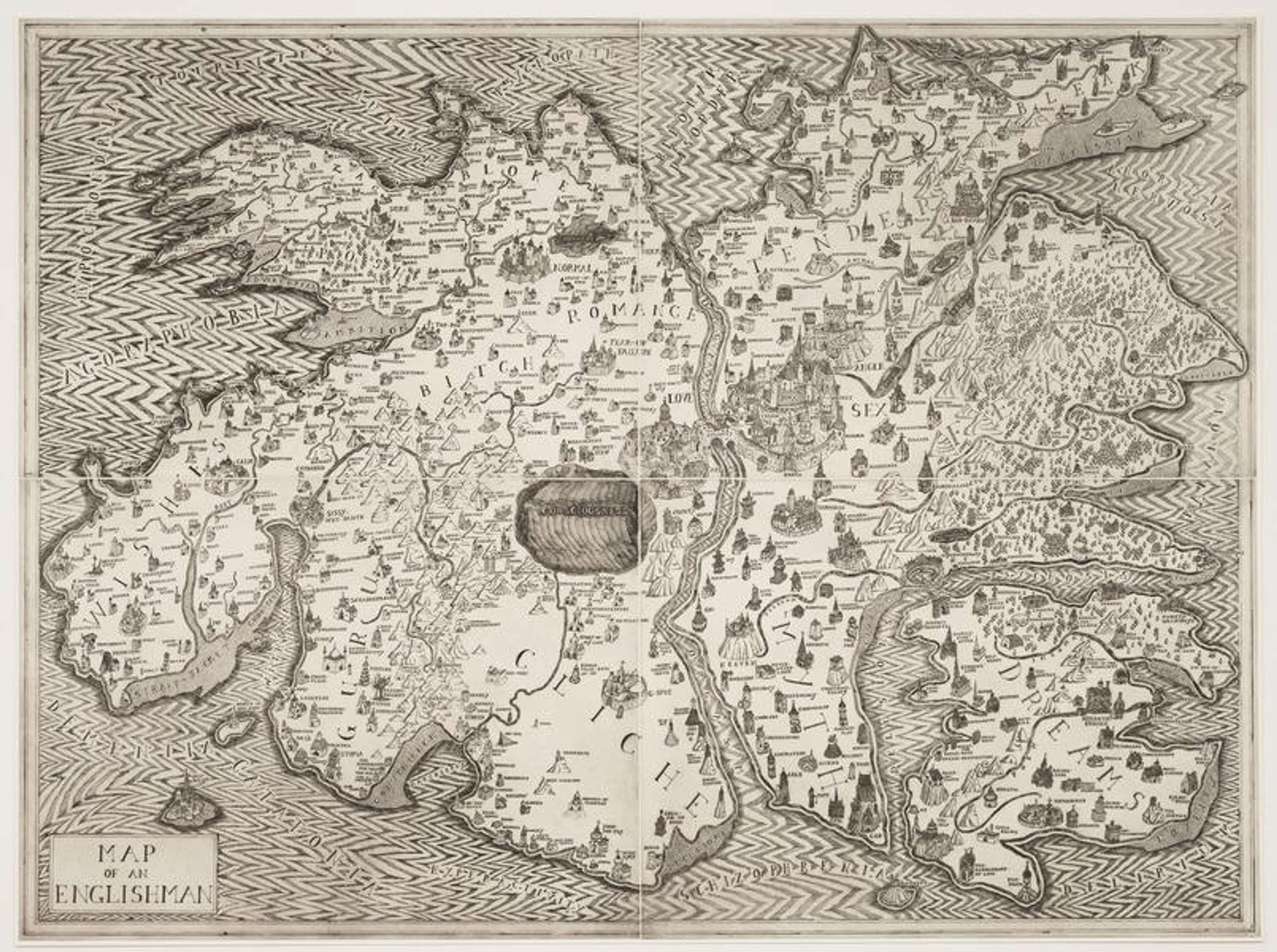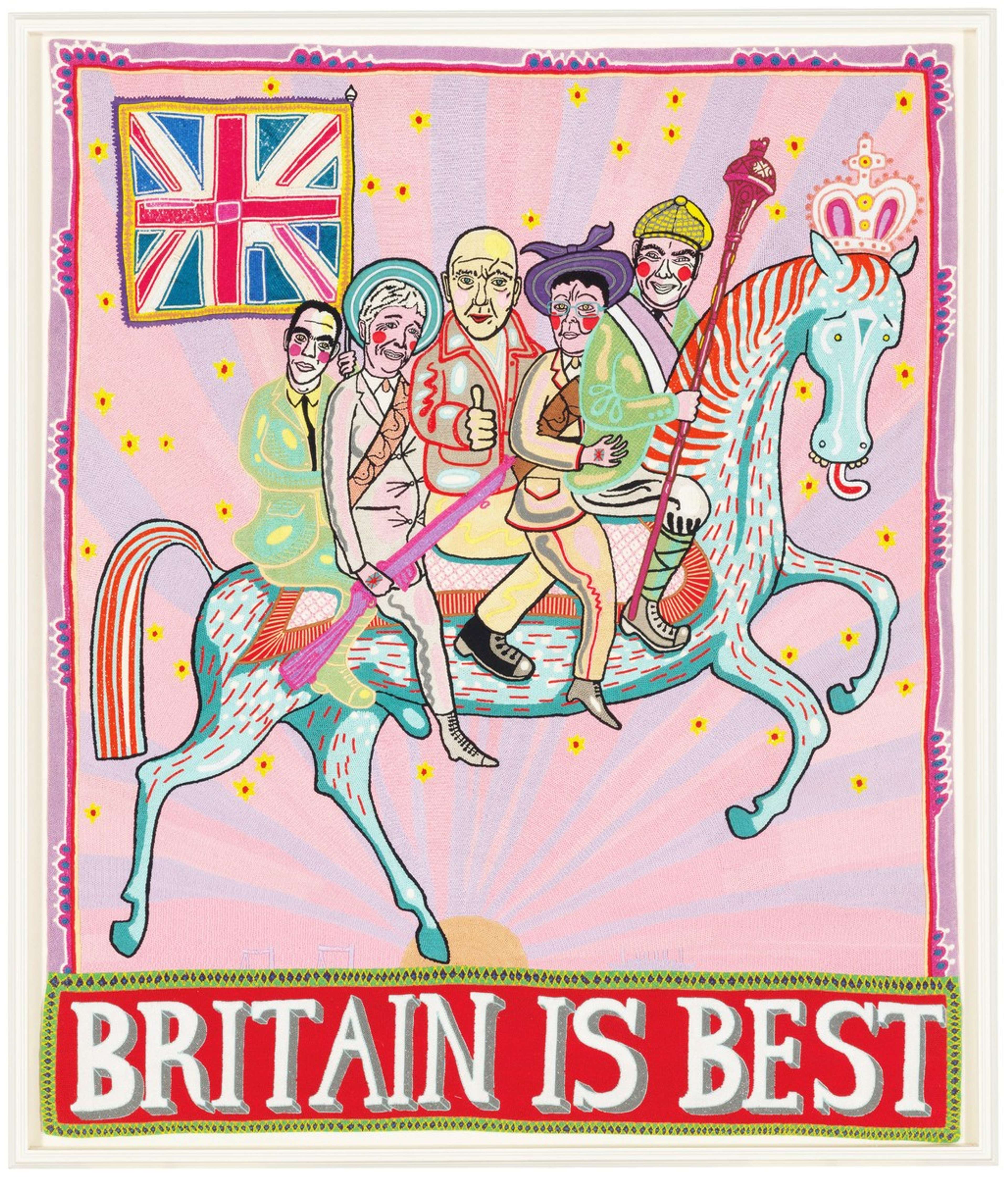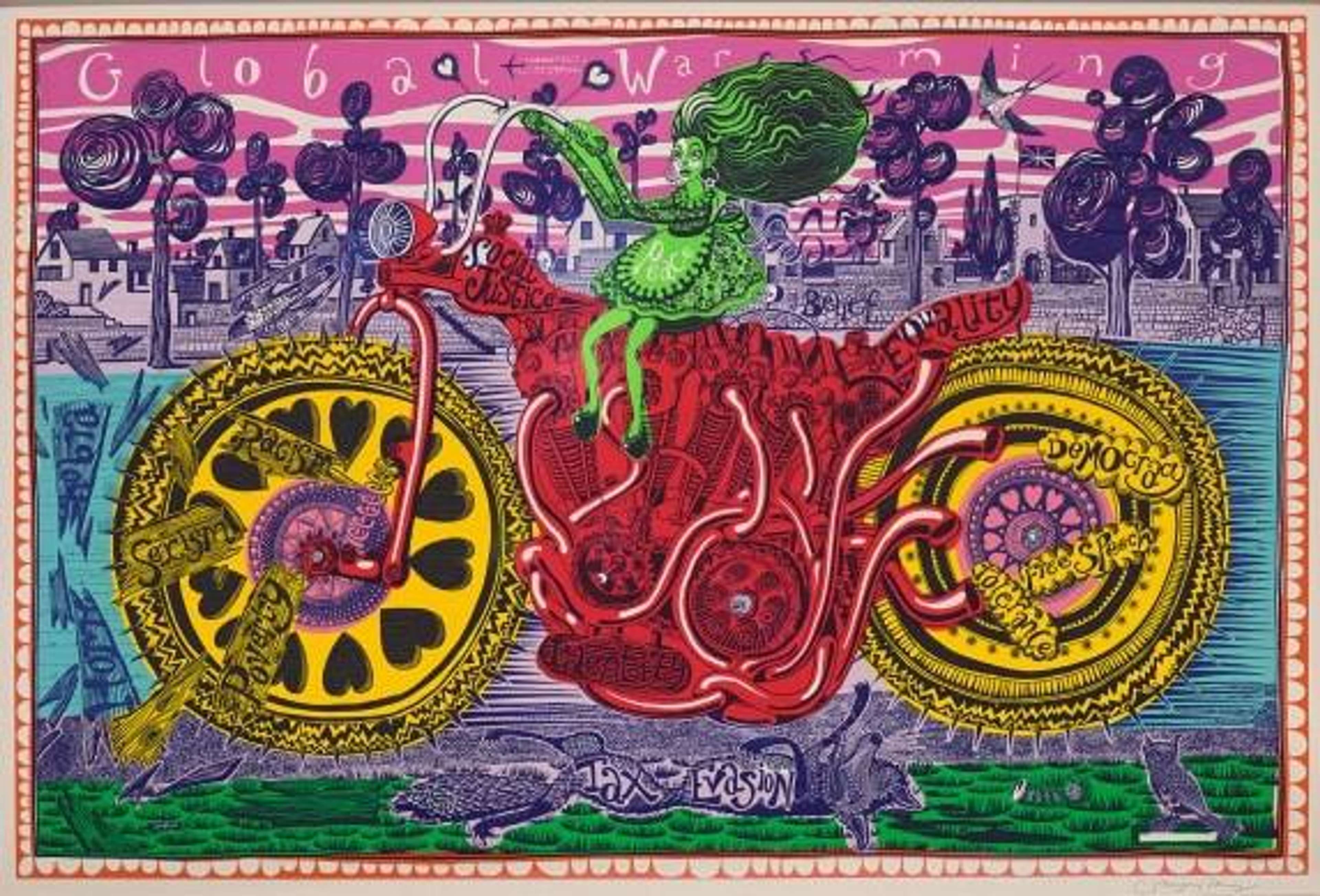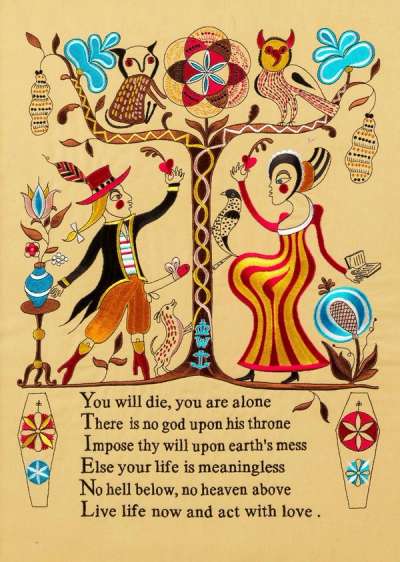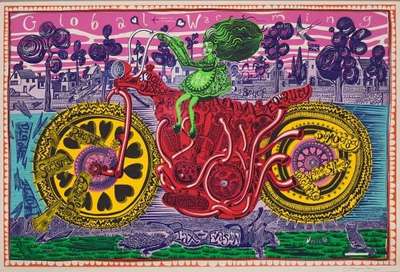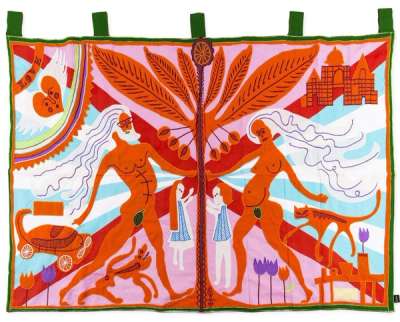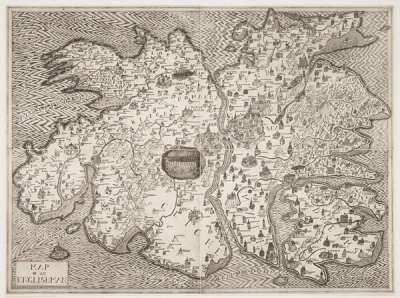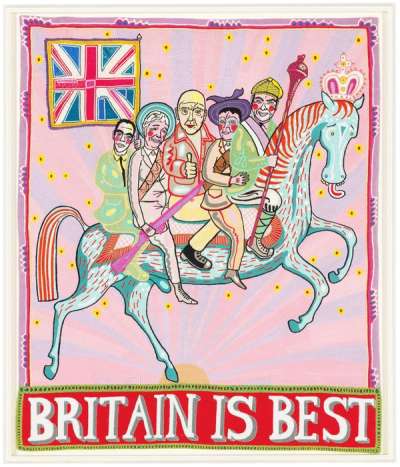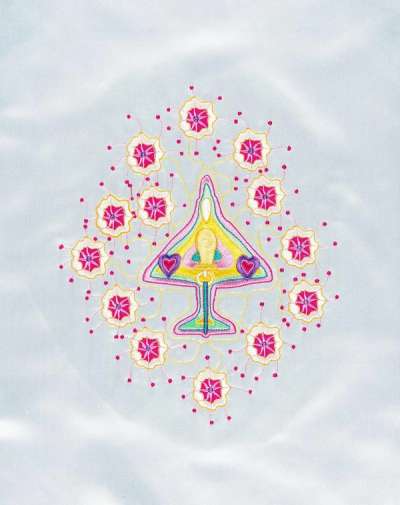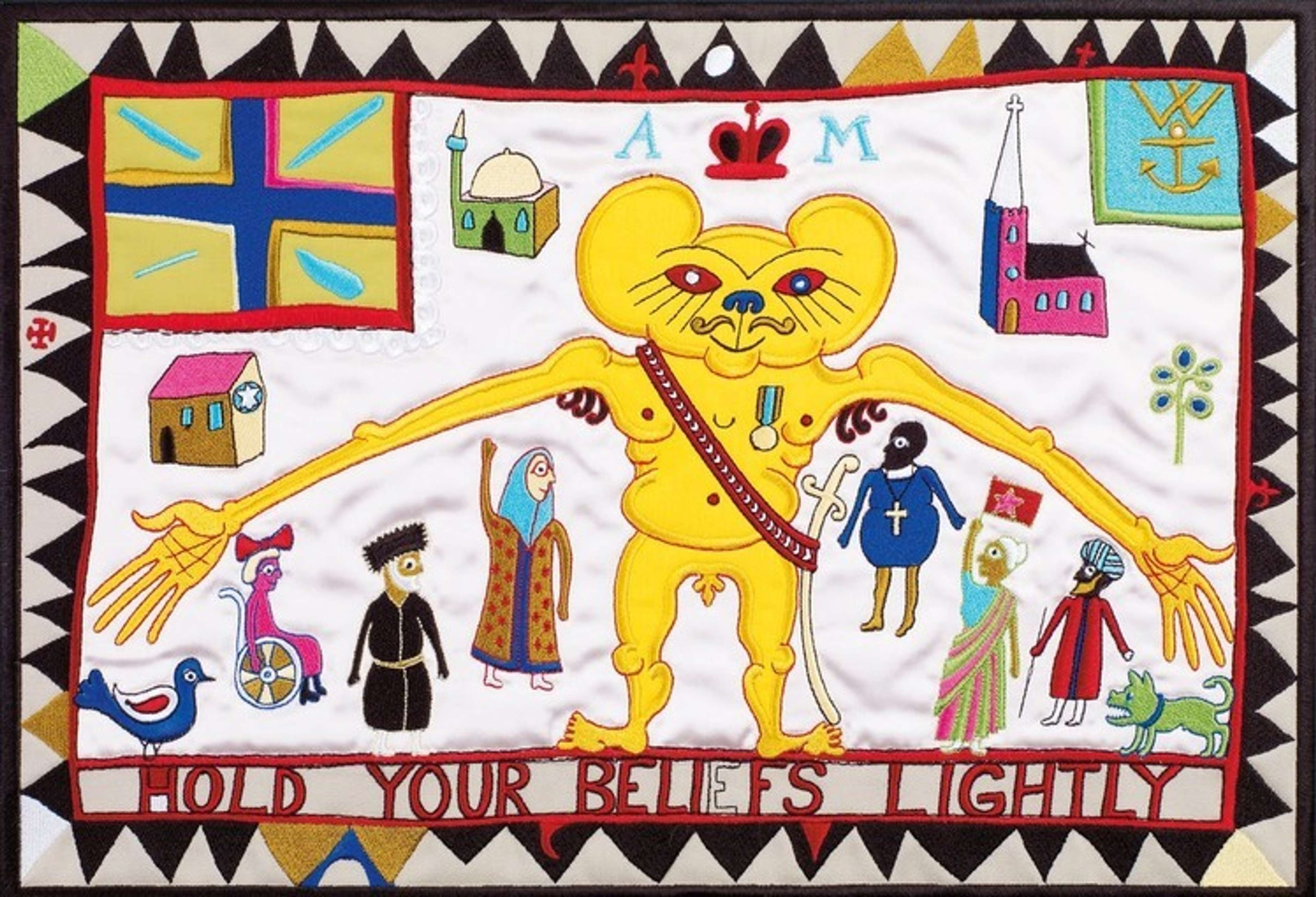The Art of Storytelling: How Grayson Perry Weaves Narratives into His Tapestries and Ceramics
 Image © Paragon Press / Comfort Blanket © Grayson Perry 2014
Image © Paragon Press / Comfort Blanket © Grayson Perry 2014
Grayson Perry
29 works
With an incisive eye and an inimitable voice, British artist Grayson Perry turns conventional artistic mediums into storytelling canvases. His tapestries and ceramics are not merely ornaments, but serve as vehicles for complex narratives about gender, class and society at large. We take a look inside Perry's intriguing world, unravelling the art of storytelling in his works, his techniques, and the symbolism that builds his intricate yet pervasive narratives.
 Image © Factum Arte / Panel from The Walthamstow Tapestry © Grayson Perry 2009
Image © Factum Arte / Panel from The Walthamstow Tapestry © Grayson Perry 2009The Art of Storytelling in Grayson Perry's Tapestries and Ceramics
The distinctive allure of Grayson Perry's work lies in his masterful storytelling, which comes to life in his tapestries and ceramics. These art forms, traditionally seen as domestic and modest, undergo a transformation under Perry's hand, turning into vibrant chronicles of contemporary life and culture.
Dabbling in pottery at art school in Portsmouth and then taking up evening classes in London, the young Perry found that ceramics offered him an endless canvas for expressing his ideas. The tapestries came later, with their width and scale providing a way to elaborate on his narratives and stretch his stories through time and space. In tandem, Perry’s tapestries and ceramics convey social narratives, intimate reflections, and personal expressions.
His art embodies a fascinating duality: the comfort of familiarity in its classical forms and the intrigue of modern storytelling. The narratives sewn into his tapestries and etched into his ceramics resonate with viewers, primarily because they mirror the objects, people and places we see in society around us.
The narrative exploration in Perry's art functions as more than decorative embellishment; it is about bringing the unspoken and unseen into a visual and symbolic context. It's a storytelling medium that beckons viewers to perceive, discuss, and rethink.
Grayson Perry's Creative Process: Techniques and Style
Perry's creative process is as nuanced and intricate as the pieces he crafts. His style is distinguished by a blend of tradition and innovation, marked by his deft social commentaries coded through symbols and icons.
As a potter, Perry pays homage to traditional ceramic craftsmanship, employing time-honoured methods to shape and fire his pots. Rather than using a wheel, he prefers to hand-build his urns and vases, which initially allowed him to make larger ceramics that could contain the detail required for in-depth narratives. His ceramics often bear a visual complexity, adorned with a wide array of designs from detailed figures and texts to bold symbols and colours.
Perry's tapestry design similarly plays with tradition. Inspired by classical works, such as those found in the historic churches of Europe, Perry’s tapestries are woven with modern machines. The process begins with a detailed sketch, which is then digitally translated into a weave pattern. The resulting tapestries hold a vibrant palette and intricate details, turning thread into a visual narrative.
 Image © Victoria Miro / Expulsion from Number 8 Eden Close © Grayson Perry 2012
Image © Victoria Miro / Expulsion from Number 8 Eden Close © Grayson Perry 2012The Meanings Contained Within Grayson Perry's Artwork
Perry's artworks are intricate visual narratives that bear witness to our society's multifaceted realities.The artist’s motifs and themes enable him to tow the line between satire and sincerity, and his visual vocabulary of symbols, icons and everyday objects is integral to this practice.
Perry uses recurring symbolism to build a relationship with his audiences. A notable instance is the recurring appearance of a teddy bear named Alan Measles, which has featured on ceramics and costumes worn by Perry’s alter ego Claire. Measles often assumes the role of an authoritative father figure or a deity, signifying a multitude of themes from innocence and childhood to authority and spirituality. The bear serves as a stark contrast against the backdrop of complex societal issues that Perry addresses, reminding viewers of the humanity at the heart of these discussions.
Perry’s use of satire and humour is in full pelt throughout his absurdist tapestries. In Expulsion from Number 8 Eden Close from The Vanity of Small Differences, for instance, Perry delivers a tongue-in-cheek narrative of class divides and identities. In the scene, Tim departs from his former life with his step-father and mother and enters the Tunbridge Wells home of his new girlfriend’s family. In what Perry describes as "the heart of the whole drama of tastes”, “the rainbow represents that Berlin Wall of taste that you step through when you enter the sunlit uplands of the upper-middle classes". Above them, chef Jamie Oliver presides over the scene as if from the heavens. The relevance? Oliver serves, as Perry puts it, as the "smiling god of class mobility".
In Perry's artistic universe, humour is a powerful vehicle for disseminating his shrewd political takes. To engage with his art is to see familiar symbols in a new light. It asks us to decipher symbolism and dig for subtext.
 Image © Paragon Press / Red Carpet © Grayson Perry 2017
Image © Paragon Press / Red Carpet © Grayson Perry 2017Weaving Narratives: Perry's Tapestries
Perry's tapestries are as rich in narrative depth as they are in colour and texture. The stories woven into these threads encapsulate a broad range of themes, from personal identity to societal norms, all rendered in Perry's characteristic mix of humour, satire, and unflinching honesty.
A notable example is the series of six tapestries The Vanity of Small Differences, which draws heavy influence from Hogarth’s satirical masterwork ‘A Rake’s Progress’. The works reflect Perry's affinity for societal commentary, presenting a visual critique on contemporary British society. Laden with social commentary, colour and everyday objects, it reveals the life story of a fictional working-class man named Tim Rakewell (perhaps a direct descendent of Hogath’s Tom Rakewell). Perry’s embroidered works follow Tim’s lifecycle as he gains economic and social status, using allusions from everyday British life to situate the viewer in the class contexts of each stage of Tim’s life.
We find another compelling narrative in Red Carpet. This tapestry, densely filled with symbols and text, maps out culture wars in British society. The work portrays various contentious issues from religion and politics to taste and etiquette, but the stylistic choices are informed by the polarised Brexit-era narratives around immigration.
Visually, the piece is uncharacteristically subtle. Perry employs a unique visual storytelling method in the piece, using a central motif of a labyrinth to reflect the convoluted and often treacherous path of societal discourse. Here, text and subtext deliver the social commentary, offering the experience of reading a piece in its most literal sense.
By bringing storytelling to the forefront of tapestry art, Perry extends an invitation to viewers to not just look, but to delve deeper; to unravel the threads of the story, and engage in a dialogue with the narrative.
 Image © Christie’s / Golden Ghosts © Grayson Perry 2000
Image © Christie’s / Golden Ghosts © Grayson Perry 2000Perry's Ceramic Pots: Etching Contemporary Social Commentary onto Traditional Forms
Perry's ceramics are perhaps his trademark medium, tracing his career from its very emergence. Perry's pots are known for their intricate detail, vibrant colours, and eclectic mix of imagery. Chosen for their seemingly inoffensive nature, Perry’s ceramics are crafted to provoke. Etched with musings, obscenities and coded images, the artist simultaneously reinforces the art of pottery and disrupts the cultural assumptions around it.
A look at his ceramic work Golden Ghosts reveals Perry's ability to imbue his pots with intricate narratives. The pot is decorated with a complex layering of images and texts that delve into Perry's personal life, exploring themes of identity, nostalgia, and belonging.
Memory Jar, another of Perry's ceramic creations, combines the aesthetics of traditional pottery with the complexity of modern storytelling. It tells the story of a long-married couple affected by Alzheimer’s Disease, causing the husband to lose sight of their shared memories. The piece concludes with the spectre of a demon who comes to cut up their family photos, symbolically rendering the loss of a lifetime of memories. As one of Perry’s most poignant pieces, Memory Jar reveals his ability to tell intimately personal stories as well as wider political ones.
The narrative elements in Perry's ceramics engage viewers and challenge the traditional norms of ceramic art. With their graphic drawings and loaded details, these vases compel the viewer to seek the stories hidden in the curves and etchings of the pottery.
 Greyson Perry stands behind his sculpture, a boat-like structure with ornaments hanging from the masts, at the British Museum.
Greyson Perry stands behind his sculpture, a boat-like structure with ornaments hanging from the masts, at the British Museum.Grayson Perry's Influence and Legacy
Perry's contribution to contemporary art and society has earned him a reputation as a household name across the UK. As a Turner Prize winner and a prominent cultural commentator, his influence reaches far beyond the boundaries of the art world.
For an artist whose schtick hinges on being a provocateur and outsider, the fact that major national institutions have sought to work alongside Perry is somewhat jarring. Nonetheless, his collaborations with influential organisations have arguably enabled him to bring alternative narratives into the cultural mainstream.
A prime example is his work with the British Museum in 2011, where he curated an exhibition titled Tomb of the Unknown Craftsman. This exhibition, in which Perry made an installation from historical artefacts in the museum’s collection, offered a nuanced commentary on the intersection of art, history, and culture. Specifically, it pays homage to the anonymous artists through history whose work has survived their personal legacies. Typically class-conscious, Perry highlights the fact that, for most of history, it was the patrons of artwork that were memorialised over the artist.
Perry's work has also had a palpable influence on other artists. His unique blend of traditional craft techniques with contentious subject matter has inspired contemporary artists to explore themes of identity, masculinity, and class in new ways. London-based artist Corbin Shaw is one artist making work in a similar vein, producing textiles based on the St Georges Cross flags typically seen in football stadiums. Like Perry, Shaw explores masculinity by disrupting the traditional connotations of this instantly recognisable symbol, while also paying tribute to the male-dominated domains that have shaped his own identity.
Beyond art, Perry effectively uses his personal platform to engage with the subject matter running through his art. His public talks and television appearances, such as his critically acclaimed 2016 series All Man, serve as platforms where Perry dissects how masculinity manifests in different social settings. His open dialogues on class, gender, and identity stand as thought-provoking contributions to public discourse, cementing his role as a notable figure in both the contemporary art market and the British cultural landscape at large.
Grayson Perry: A Testament to Power of Storytelling in Art
Through his shrewd observations and compelling visual style, Perry has become a pervasive presence in contemporary art. His tapestries and ceramics offer more than visual allure; they convey profound narratives, serving as mirrors to our society's complexities and contradictions. Using symbolism, satire, and social commentary, Perry's artworks weave narratives of personal expression and cultural critique.
As a central figure in the British cultural landscape, Perry's storytelling prowess challenges our perceptions, invites dialogue, and encourages a deeper art appreciation. His work serves as a compelling testament to the enduring impact of artistic narratives and the role art has to play as a vessel for storytelling.

